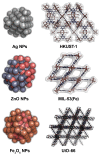Metal Nanomaterials and Hydrolytic Enzyme-Based Formulations for Improved Antifungal Activity
- PMID: 37511117
- PMCID: PMC10379199
- DOI: 10.3390/ijms241411359
Metal Nanomaterials and Hydrolytic Enzyme-Based Formulations for Improved Antifungal Activity
Abstract
Active research of metal-containing compounds and enzymes as effective antifungal agents is currently being conducted due to the growing antifungal resistance problem. Metals are attracting special attention due to the wide variety of ligands that can be used for them, including chemically synthesized and naturally obtained variants as a result of the so-called "green synthesis". The main mechanism of the antifungal action of metals is the triggering of the generation and accumulation of reactive oxygen species (ROS). Further action of ROS on various biomolecules is nonspecific. Various hydrolytic enzymes (glucanases and proteases), in turn, exhibit antifungal properties by affecting the structural elements of fungal cells (cell walls, membranes), fungal quorum sensing molecules, fungal own protective agents (mycotoxins and antibiotics), and proteins responsible for the adhesion and formation of stable, highly concentrated populations in the form of biofilms. A wide substrate range of enzymes allows the use of various mechanisms of their antifungal actions. In this review, we discuss the prospects of combining two different types of antifungal agents (metals and enzymes) against mycelial fungi and yeast cells. Special attention is paid to the possible influence of metals on the activity of the enzymes and the possible effects of proteins on the antifungal activity of metal-containing compounds.
Keywords: His6-OPH; MOFs; amyloid proteins; biofilms; chitinases; green synthesis; growth inhibition; lactamases; lactonases; mycotoxins; prionase; quorum quenching; quorum sensing.
Conflict of interest statement
The authors declare no conflict of interest.
Figures


References
-
- Garg D., Muthu V., Sehgal I.S., Ramachandran R., Kaur H., Bhalla A., Puri G.D., Chakrabarti A., Agarwal R. Coronavirus disease (COVID-19) associated mucormycosis (CAM): Case report and systematic review of literature. Mycopathologia. 2021;186:289–298. doi: 10.1007/s11046-021-00528-2. - DOI - PMC - PubMed
-
- World Health Organization . WHO Fungal Priority Pathogens List to Guide Research, Development and Public Health Action. World Health Organization; Geneva, Switzerland: 2022. [(accessed on 29 May 2023)]. p. 48. Available online: https://www.who.int/publications/i/item/9789240060241.
Publication types
MeSH terms
Substances
Grants and funding
LinkOut - more resources
Full Text Sources

